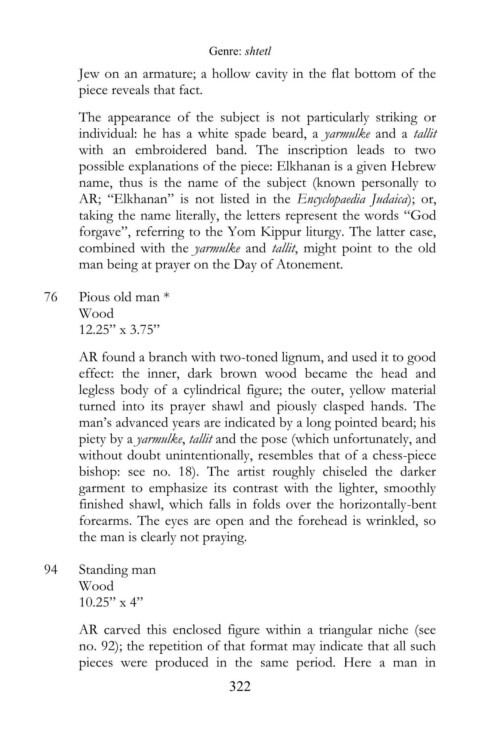Page 326 - The Legacy of Abraham Rothstein - text
P. 326
Genre: shtetl
Jew on an armature; a hollow cavity in the flat bottom of the
piece reveals that fact.
The appearance of the subject is not particularly striking or
individual: he has a white spade beard, a yarmulke and a tallit
with an embroidered band. The inscription leads to two
possible explanations of the piece: Elkhanan is a given Hebrew
name, thus is the name of the subject (known personally to
AR; “Elkhanan” is not listed in the Encyclopaedia Judaica); or,
taking the name literally, the letters represent the words “God
forgave”, referring to the Yom Kippur liturgy. The latter case,
combined with the yarmulke and tallit, might point to the old
man being at prayer on the Day of Atonement.
76 Pious old man *
Wood
12.25” x 3.75”
AR found a branch with two-toned lignum, and used it to good
effect: the inner, dark brown wood became the head and
legless body of a cylindrical figure; the outer, yellow material
turned into its prayer shawl and piously clasped hands. The
man’s advanced years are indicated by a long pointed beard; his
piety by a yarmulke, tallit and the pose (which unfortunately, and
without doubt unintentionally, resembles that of a chess-piece
bishop: see no. 18). The artist roughly chiseled the darker
garment to emphasize its contrast with the lighter, smoothly
finished shawl, which falls in folds over the horizontally-bent
forearms. The eyes are open and the forehead is wrinkled, so
the man is clearly not praying.
94 Standing man
Wood
10.25” x 4”
AR carved this enclosed figure within a triangular niche (see
no. 92); the repetition of that format may indicate that all such
pieces were produced in the same period. Here a man in
322

